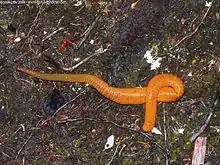Arhynchobdellida
Arhynchobdellida, the proboscisless leeches, are classified as an order of the Hirudinea. More recently, this order has been rejected and replaced with a newer classification.[1] Still, leech taxonomy and systematics may eventually need to be revised, not because of the many uncertainties exist about their phylogeny, but because the major clades of clitellate annelids - and whether the clitellates are themselves are a clade - have not been fully elucidated. For example, the "true leeches" (Euhirudinea) might actually be synonymous with the Hirudinea, as all other leech-like annelids might not be very closely related to the true leeches.
| Proboscisless leeches | |
|---|---|
 | |
| A giant Americobdella species from southern Chile. | |
| Scientific classification | |
| Kingdom: | Animalia |
| Phylum: | Annelida |
| Class: | Clitellata |
| Subclass: | Hirudinea |
| Infraclass: | Euhirudinea |
| Order: | Arhynchobdellida Blanchard, 1894 |
| Suborders | |
|
Erpobdelliformes | |
| Synonyms | |
|
Arhynchobdellae Stuart, 1982 | |
Proboscisless leeches are generally freshwater or amphibious animals. They have usually six to eight, sometimes five pairs of eyes. Some - among them the well-known European medical leech (Hirudo medicinalis) of the Hirudiniformes - are bloodsuckers, while most - including the Kinabalu giant red leech (Mimobdella buettikoferi) of the Erpobdelliformes - are predators that hunt small invertebrates, which are swallowed whole.
Systematics and taxonomy
Given the systematic uncertainties, the proboscisless leeches have been treated at varying ranks, and the alternate name Arhynchobdellae is also sometimes found.
Arhynchobdellida systematics has been revised in modern times. Formerly, they could be divided into jawed and a jawless orders. However, the lack of jaws does not denote a particularly close relationship. Jawed leeches are more numerous, but exclusively found among the Hirudiniformes, while the jawless Pharyngobdellida (or Pharyngobdellae), also known as "worm-leeches, are more diverse and occur in the Hirudiniformes and the Erpobdelliformes alike.
In addition to the two orders accepted today, a more basal lineage exists. These, the Americobdellidae, are not assigned order rank, but are treated as a family to signify their phylogenetic position near the base of the Arhynchobdellida. They are massive annelids, measuring 30 cm long in some cases, and are anatomically primitive. These animals hunt earthworms, which they suck in one piece through their toothless mouths.[2]
References
- Tessler, Michael; de Carle, Danielle; Voiklis, Madeleine L.; Gresham, Olivia A.; Neumann, Johannes S.; Cios, Stanisław; Siddall, Mark E. (October 2018). "Worms that suck: Phylogenetic analysis of Hirudinea solidifies the position of Acanthobdellida and necessitates the dissolution of Rhynchobdellida". Molecular Phylogenetics and Evolution. 127: 129–134. doi:10.1016/j.ympev.2018.05.001.
- Siddall, M.E. & Borda, E. (2004): Leech collections from Chile Including Two New Species of Helobdella. American Museum Novitates 3457: 1-18. PDF fulltext
| Wikispecies has information related to Arhynchobdellida. |